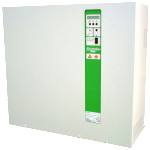Isothermal and adiabatic humidification
Two different processes exist and can be set up to increase the percentage of moisture of the air :
- Isothermal humidification
- Adiabatic humidification
In isothermal humidification, water is carried until boiling to be dispersed in the air. This process requires a source of energy however as the mass of the steam is lower than that of the air, the temperature of the air remains stable.
Fogging systems use compressed air to atomize water and create a stream of microscopic water particles which appears as fog. The water particles quickly change from liquid to gas as they absorb heat from the surrounding air. It is a constant enthalpy process and air decreases its temperature. This evaporative cooling can provide energy benefits for systems with high internal heat loads.




